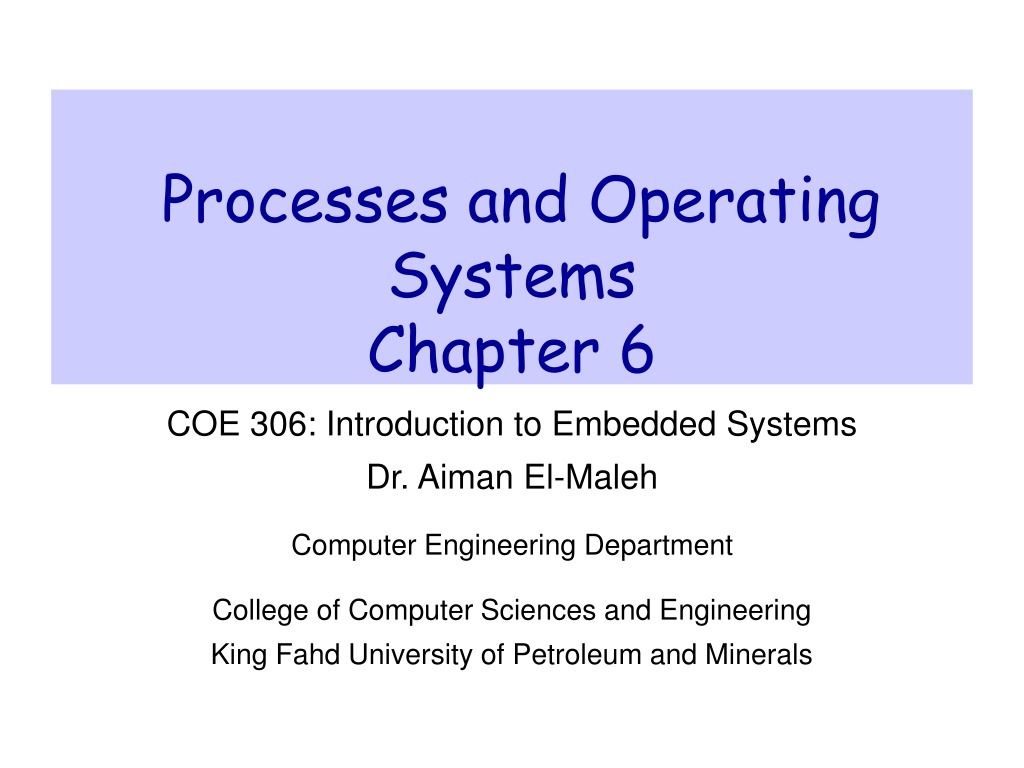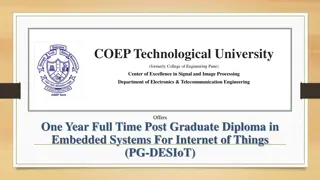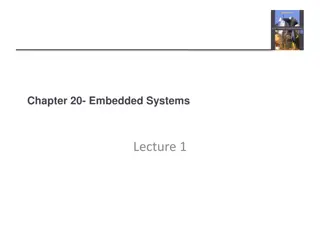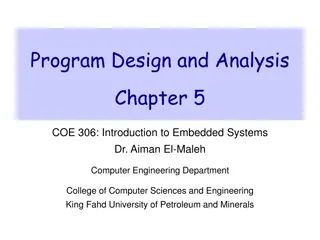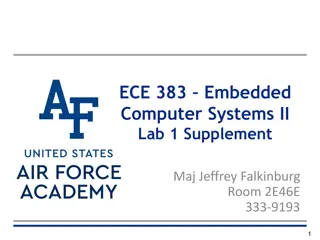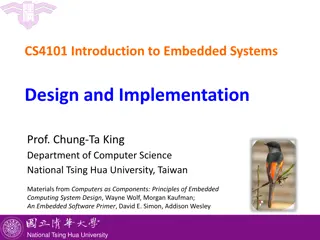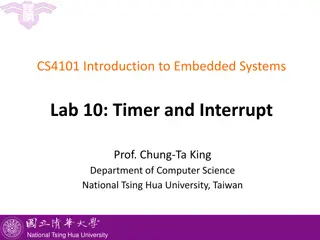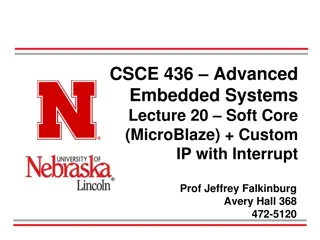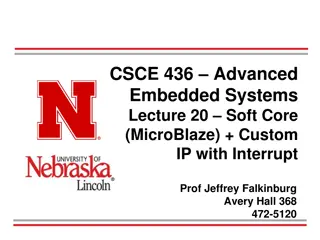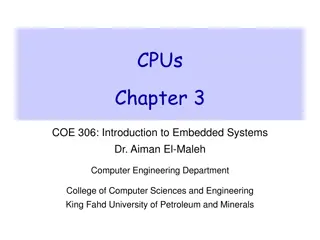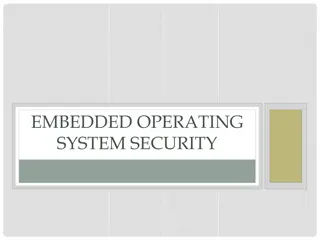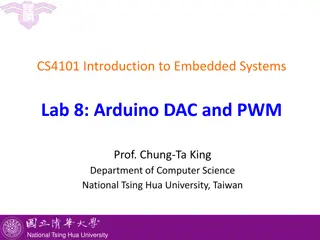Introduction to Processes and Operating Systems in Embedded Systems
Processes and operating systems play a crucial role in building complex applications on microprocessors, offering flexibility to meet timing requirements. The operating system (OS) manages processes by providing mechanisms for switching execution between them. Real-Time Operating Systems (RTOS) are essential for satisfying real-time requirements and allocating resources based on these needs. Tasks and processes are functional descriptions of operations, helping to manage timing complexities in various systems.
Download Presentation

Please find below an Image/Link to download the presentation.
The content on the website is provided AS IS for your information and personal use only. It may not be sold, licensed, or shared on other websites without obtaining consent from the author. Download presentation by click this link. If you encounter any issues during the download, it is possible that the publisher has removed the file from their server.
E N D
Presentation Transcript
Processes and Operating Systems Chapter 6 COE 306: Introduction to Embedded Systems Dr. Aiman El-Maleh Computer Engineering Department College of Computer Sciences and Engineering King Fahd University of Petroleum and Minerals
Next . . . Processes and Operating Systems Real Time Operating System (RTOS) The Scheduling Problem Rate Monotonic Scheduling (RMS) Earliest-Deadline-First Scheduling (EDFS) FreeRTOS Processes and Operating Systems COE 306 Introduction to Embedded System KFUPM slide 2
Processes and Operating Systems Processes and operating system are abstractions allow us to build complex applications on microprocessors provide much greater flexibility to satisfy timing requirements Let us switch the state of the processor between multiple tasks Process defines the state of an executing program A process is a unique execution of a program Several copies of a program may run simultaneously or at different times A process has its own state: registers and memory Threads share the same address space Processes and Operating Systems COE 306 Introduction to Embedded System KFUPM slide 3
Processes and Operating Systems The Operating System (OS) manages processes OS provides the mechanism for switching execution between processes Real-Time Operating System (RTOS) is OS that provides facilities for satisfying real-time requirements Allocates resources based on real-time requirements General-purpose OSs use other criteria, e.g. fairness RTOS helps build more complex systems using several programs that run concurrently Processes and Operating Systems COE 306 Introduction to Embedded System KFUPM slide 4
Tasks and Processes A task is a functional description of a connected set of operations Task can also mean a collection of processes Multiple tasks means multiple processes Multiple processes help with timing complexity: multiple rates multimedia automotive asynchronous input user interfaces communication systems Processes and Operating Systems COE 306 Introduction to Embedded System KFUPM slide 5
Compression Unit Example Variable data rates need to receive and send data at different rates program may emit two bits for first byte and then seven bits for second byte must ensure to process inputs and outputs at the proper rates Asynchronous input a compression mode button that disables or enables compression Keeping up with input and output data while checking on button can introduce complex control code into program Processes and Operating Systems COE 306 Introduction to Embedded System KFUPM slide 6
Compression Unit Example Sampling the button s state too slowly can cause the machine to miss a button depression entirely Sampling it too frequently can cause the machine to incorrectly compress data due to executing later than expected Variable execution times of code causes other code to execute later than expected We need to be able to keep track of these two different tasks separately, applying different timing requirements to each Complex control is usually quite difficult to verify for either functional or timing properties Processes and Operating Systems COE 306 Introduction to Embedded System KFUPM slide 7
Multi-Rate Systems Multirate embedded computing systems are very common, including automobile engines, printers, and cell phones Certain operations must be executed periodically, and each operation is executed at its own rate Tasks may be synchronous or asynchronous Synchronous tasks may recur at different rates Processes run at different rates based on computational needs of the tasks Processes and Operating Systems COE 306 Introduction to Embedded System KFUPM slide 8
Example: Engine Control Tasks: spark control Firing the spark plug periodically Spark timing varies with engine speed regulate exhaust emissions crankshaft sensing fuel/air mixture oxygen sensor multimode control scheme engine warm-up , cruise, climbing steep hills Rates at which engine inputs and outputs must be handled range between 2ms and 1s Processes and Operating Systems COE 306 Introduction to Embedded System KFUPM slide 9
Typical Rates in Engine Controllers Variable Engine spark timing Throttle Air flow Battery voltage Fuel flow Recycled exhaust gas Status switches Air temperature Barometric pressure Spark (dwell) Fuel adjustment Carburetor Mode actuators Update period (ms) 2 2 4 4 10 25 20 400 1000 1 8 25 100 Processes and Operating Systems COE 306 Introduction to Embedded System KFUPM slide 10
Real-Time Systems Perform a computation to conform to external timing constraints Deadline frequency: Periodic Aperiodic Deadline type: Hard: failure to meet deadline causes system failure Car Airbag system, car brakes Soft: failure to meet deadline causes degraded response Room temperature control, car multimedia system Firm: late response is useless; Infrequent deadline misses are tolerable, but may degrade the system's quality of service A digital cable set-top box frame decoder Processes and Operating Systems COE 306 Introduction to Embedded System KFUPM slide 11
Types of Process Timing Requirements Release time: time at which process becomes ready to execute Deadline: time at which process must finish execution Periodic process: a process executes every period e.g. Firing the spark plugs Aperiodic process: executes on demand Processing a button press Period : interval between process activations Initiation Interval or Rate = 1/period Processes and Operating Systems COE 306 Introduction to Embedded System KFUPM slide 12
Types of Process Timing Requirements Jitter: Allowable variation in task completion time Example: multimedia synchronization What happens when a process misses a deadline? Can be catastrophic such as in an automotive control system a missed deadline in a telephone system may cause a temporary silence on the line Example: Space Shuttle software error Space Shuttle s first launch was delayed by a software timing error Change to one routine added delay that threw off start time calculation Processes and Operating Systems COE 306 Introduction to Embedded System KFUPM slide 13
Task Graphs Tasks may have data dependencies---must execute in certain order Task graph shows data/control dependencies between processes Task: connected set of processes Task set: One or more tasks Task graph assumes that all processes in each task run at the same rate, tasks do not communicate In reality, some amount of inter-task communication is necessary Processes and Operating Systems COE 306 Introduction to Embedded System KFUPM slide 14
Process Execution Characteristics Process execution time Ti Execution time in absence of preemption Possible time units: seconds, clock cycles Worst-case, best-case execution time may be useful in some cases Sources of variation: Data dependencies Memory system CPU pipeline Processes and Operating Systems COE 306 Introduction to Embedded System KFUPM slide 15
CPU Utilization CPU utilization Fraction of the CPU that is doing useful work Often calculated assuming no scheduling overhead Utilization: U = (CPU time for useful work) / (total available CPU time) Utilization over a time interval [t1, t2] = ????? ??(?2 ?1) ?2 ?1 = T/t Processes and Operating Systems COE 306 Introduction to Embedded System KFUPM slide 16
Running Periodic Processes Need code to control execution of processes Simplest implementation: process = subroutine While loop implementation while (TRUE) { } p1(); p2(); Simplest implementation has one loop No control over execution timing Pad the loop with NOP instructions Used by some video games in the 1970s Broken: hard to determine execution time, conditionals, re- evaluation upon code change Processes and Operating Systems COE 306 Introduction to Embedded System KFUPM slide 17
Running Periodic Processes Timed loop implementation void pall() { } Encapsulate set of all processes in a single function that implements the task set p1(); p2(); Use timer to control execution of the task No control over timing of individual processes Multiple timers implementation void A(){ /* rate A */ p1(); p3(); } void B(){ /* rate B */ p2(); p4(); p5(); } Each task has its own function Each task has its own timer May not have enough timers to implement all the rates Processes and Operating Systems COE 306 Introduction to Embedded System KFUPM slide 18
Running Periodic Processes Timer + counter implementation int p2count = 0; void pall(){ p1(); if (p2count >= 2) { p2(); p2count = 0; } else p2count++; p3(); } Use a software count to divide the timer Only works for clean multiples of the timer period Implementing processes All of these implementations are inadequate. Need better control over timing Need a better mechanism than subroutines Real-time operating systems (RTOS) Processes and Operating Systems COE 306 Introduction to Embedded System KFUPM slide 19
Operating Systems The operating system controls resources who gets the CPU when I/O takes place how much memory is allocated The most important resource is the CPU itself CPU access controlled by the scheduler Processes and Operating Systems COE 306 Introduction to Embedded System KFUPM slide 20
Real-Time Operating Systems Solves the main problems of a cooperative multitasking system Executes processes based on timing requirements provided by system designer Based on two basic concepts: Preemption: the ability to interrupt a process to switch to another Context switching: switching execution and CPU state between processes Processes and Operating Systems COE 306 Introduction to Embedded System KFUPM slide 21
State of a Process A process can be in one of three states: executing on the CPU ready to run waiting for I/O, another process, timer, next period The operating system selects the next executing process At most one executing process Processes and Operating Systems COE 306 Introduction to Embedded System KFUPM slide 22
Preemptive Execution Kernel: part of the OS. Determines which process runs The kernel is activated periodically by the timer The timer period is known as the time quantum The smallest time unit in which CPU activity can be controlled Processes and Operating Systems COE 306 Introduction to Embedded System KFUPM slide 23
Context Switching Context: The set of registers that define a process Context Switching: Switching the registers from one process to another Timer interrupt: transfer control from a process to kernel Kernel saves current process context Kernel selects next process (scheduling) Kernel restores next process context Context switching code is usually assembly code Task priorities make selecting processes flexible and fast Processes and Operating Systems COE 306 Introduction to Embedded System KFUPM slide 24
Context Switching in FREERTOS Processes and Operating Systems COE 306 Introduction to Embedded System KFUPM slide 25
The Scheduling Problem Choosing the order of running processes is known as scheduling Workstations try to avoid starving processes of CPU access Fairness = access to CPU Embedded systems must meet deadlines Low-priority processes may not run for a long time Scheduling feasibility Resource constraints make schedulability analysis NP-hard Must show that the deadlines are met for all timings of resource requests Processes and Operating Systems COE 306 Introduction to Embedded System KFUPM slide 26
Scheduling Feasibility Assume: No resource conflicts Constant process execution times Require: T (period) i Ti Can t use more than 100% of the CPU. Hyperperiod: least common multiple (LCM) of the task periods Must look at the hyperperiod schedule to find all task interactions Hyperperiod can be very long if task periods are not chosen carefully Processes and Operating Systems COE 306 Introduction to Embedded System KFUPM slide 27
Hyperperiod Example Long hyperperiod: P1 7 ms P2 11 ms P3 15 ms LCM = 1155 ms Example: Shorter hyperperiod: P1 8 ms P2 12 ms P3 16 ms LCM = 96 ms P1 period 1 ms, CPU time 0.1 ms LCM Peirod 5.00E-03 CPU time CPU*LCM/P P2 period 1 ms, CPU time 0.2 ms P1 P2 P3 1.00E-03 1.00E-03 5.00E-03 1.00E-04 2.00E-04 3.00E-04 5.00E-04 1.00E-03 3.00E-04 P3 period 5 ms, CPU time 0.3 ms Total CPU Utilization 1.80E-03 36% Processes and Operating Systems COE 306 Introduction to Embedded System KFUPM slide 28
Round-Robin Scheduling All the processes are kept on a list and scheduled one after the other Time slices are assigned to each process in equal portions and in circular order Common in general-purpose Oses Schedule process only if ready Always test processes in the same order Start round-robin again after finishing a round Schedule based on least common multiple (LCM) of the process periods Processes and Operating Systems COE 306 Introduction to Embedded System KFUPM slide 29
Priority-Based Scheduling Each process has a priority CPU goes to highest-priority process that is ready Priorities determine scheduling policy: fixed priority time-varying priorities Example: each process has a fixed priority (1 highest) highest-priority ready process gets CPU process continues until done Processes and Operating Systems COE 306 Introduction to Embedded System KFUPM slide 30
Priority-Based Scheduling Example P3 ready t=18 P2 ready t=0 P1 ready t=15 P2 P1 P2 P3 30 60 0 10 20 40 50 time Processes and Operating Systems COE 306 Introduction to Embedded System KFUPM slide 31
Scheduling Metrics How do we evaluate a scheduling policy: Ability to satisfy all deadlines CPU utilization---percentage of time devoted to useful work Scheduling overhead---time required to make scheduling decision Processes and Operating Systems COE 306 Introduction to Embedded System KFUPM slide 32
Rate Monotonic Scheduling (RMS) RMS is widely-used, analyzable scheduling policy A static scheduling policy: processes have fixed priorities RMS Model All processes run on single CPU Context switching time is ignored No data dependencies between processes Process execution time is constant All deadlines are at the end of the period Highest-priority ready process runs first Priority assignment: The process with the shortest period is assigned the highest priority Processes and Operating Systems COE 306 Introduction to Embedded System KFUPM slide 33
Rate Monotonic Scheduling (RMS) RMS always provides a feasible schedule if such a schedule exists Optimal static assignment No fixed-priority scheme does better Highest CPU utilization while ensuring that all processes meet their deadlines Ti is computation time of process i i is period of process i Absolute deadline Released Execution time Ti i Processes and Operating Systems COE 306 Introduction to Embedded System KFUPM slide 34
Rate Monotonic Scheduling Example What if execution times become 2, 3, 3? Processes and Operating Systems COE 306 Introduction to Embedded System KFUPM slide 35
Rate Monotonic Analysis (RMA) There are cases where first relationship can be satisfied and second cannot. If P1 has higher priority, required constraint on CPU time: There are no cases where second relationship can be satisfied and first cannot Consider T1=2 and T2=2, 1=3, 2=6. If P2 has higher priority, required constraint on CPU time: Processes and Operating Systems COE 306 Introduction to Embedded System KFUPM slide 36
RMS CPU utilization Utilization for n processes is: Given n processes and ratio between any two periods less than 2, RMS CPU utilization upper bound: RM Utilization Bounds 1.1 1 Utilization 0.9 n = 2; U 0.83 0.8 0.7 0.6 n = 3; n ; U 0.78 0.5 1 4 16 64 256 1024 4096 U ln2 0.69, 31% idle time The Number of Tasks RMS may not be able to use 100% of CPU, even with zero context switch overhead Processes and Operating Systems COE 306 Introduction to Embedded System KFUPM slide 37
RMS CPU Utilization Example Utilization = 1/4 + 2/6 + 3/12 = 0.83 Processes and Operating Systems COE 306 Introduction to Embedded System KFUPM slide 38
Response Time Response time Duration from released time to finish time Response Time (1,4) P1 (2,5) P2 5 10 15 (2,10) P3 5 10 15 Processes and Operating Systems COE 306 Introduction to Embedded System KFUPM slide 39
Response Time Response Time (ri) [Audsley et al., 1993] r i = + r T T i i k k ( ) P HP P k i HP(Pi) : a set of higher-priority tasks than Pi Real-time system is schedulable under RMS if and only if ri i for all processes Pi(Ti, i) Processes and Operating Systems COE 306 Introduction to Embedded System KFUPM slide 40
Response Time Response time computation for P3 r3 = 2 + 0 = 2 r i r3 = 2 + 2 + 1 = 5 = + r T T i i k r3 = 2 + 2 + 2 = 6 k ( ) P HP P k i r3 = 2 + 4 + 2 = 8 r3 = 2 + 4 + 2 = 8 Processes and Operating Systems COE 306 Introduction to Embedded System KFUPM slide 41
RMS- Schedulability Check A set of n processes is schedulable on a uniprocessor by the RMS algorithm if the processor utilization (utilization test): This condition is sufficient, but not necessary If U is less than the given bound, a schedule exists If there is a schedule, U could be greater than the bound Example: P1: (T1=1, 1=2), P2: (T2=2, 2=4) There is a schedule with U=100% Processes and Operating Systems COE 306 Introduction to Embedded System KFUPM slide 42
Another RMS Example P1: T1=1, 1=4 P2: T2=2, 2=5 P3: T3=2, 2=7 (1,4) P1 (2,5) P2 5 10 15 (2,7) P3 5 10 15 Processes and Operating Systems COE 306 Introduction to Embedded System KFUPM slide 43
Another RMS Example (1,4) P1 (2,5) P2 5 10 15 (2,7) P3 5 10 15 Processes and Operating Systems COE 306 Introduction to Embedded System KFUPM slide 44
Another RMS Example Deadline Miss ! (1,4) P1 (2,5) P2 5 10 15 (2,7) P3 5 10 15 Processes and Operating Systems COE 306 Introduction to Embedded System KFUPM slide 45
Earliest-Deadline-First Scheduling EDFS: dynamic priority scheduling scheme Process closest to its deadline has highest priority Requires recalculating processes priorities at every timer interrupt Can achieve 100% utilization;higher utilization than RMS On each timer interrupt compute time to deadline choose process closest to deadline Optimal scheduling algorithm if there is a schedule for a set of real-time tasks, EDF can schedule it Processes and Operating Systems COE 306 Introduction to Embedded System KFUPM slide 46
EDFS Example P1: T1=1, 1=4 P2: T2=2, 2=5 P3: T3=2, 2=7 (1,4) P1 (2,5) P2 5 10 15 (2,7) P3 5 10 15 Processes and Operating Systems COE 306 Introduction to Embedded System KFUPM slide 47
EDFS Example (1,4) P1 (2,5) P2 5 10 15 (2,7) P3 5 10 15 Processes and Operating Systems COE 306 Introduction to Embedded System KFUPM slide 48
EDFS Example (1,4) P1 (2,5) P2 5 10 15 (2,7) P3 5 10 15 Processes and Operating Systems COE 306 Introduction to Embedded System KFUPM slide 49
EDFS Example (1,4) P1 (2,5) P2 5 10 15 (2,7) P3 5 10 15 Processes and Operating Systems COE 306 Introduction to Embedded System KFUPM slide 50
